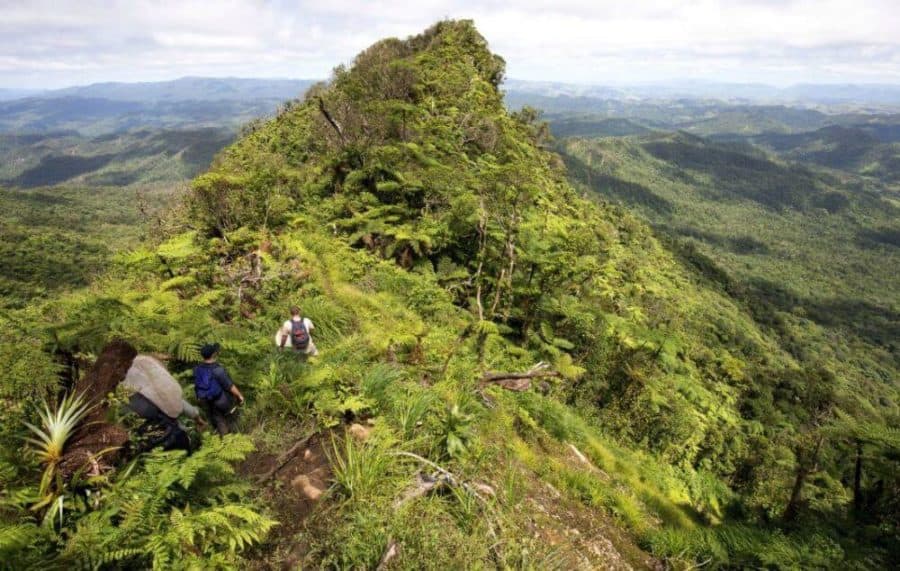A treasure trove of new species have been discovered in Fiji’s highlands after several New Colombo Plan student study tours.
Three successive years of federal New Colombo Plan funding has enabled Flinders University, in collaboration with University of South Australia, the South Australian Museum, and the University of the South Pacific, to explore terrestrial biodiversity in Fiji – and led to the unexpected discovery of many new species.
For example, before the project began in 2016, there were only three known species of Fijian native bees. The most recent research excursion, completed in April 2018, indicates there are more than 20 species.
Surprisingly, most of these new species are limited to specific mountain regions, sometimes only a few kilometres away from each other.
This all supports an intriguing evolutionary biology puzzle that researchers are now keen to explore further, says Flinders University Associate Professor Michael Schwarz.
“Our research findings are adding to the scientific understanding of the country’s rich biodiversity,” he says.
The most recent field trip in April included research into butterflies and pollination networks, to gain a deeper understanding of how Fiji has evolved into a tropical biodiversity hotspot.
They found the native Fijian bees’ love for pollen from introduced species could be a major threat to the Pacific island’s ecosystems.
Associate Professor Schwarz says the effectiveness of Fijian bees in pollinating introduced weeds is allowing the plants to spread at an alarming rate, making Fiji especially vulnerable to exotic plant species.
“These findings shed light on areas like kin recognition, and food sharing that dates back to the Eocene, at least 45 million years ago,” says Associate Professor Schwarz.
Nature photographer and Flinders PhD student James Dorey has begun documenting Fijian butterflies to produce the first authoritative field guide to this stunning group of insects, along with genetic analyses to study their evolutionary origins.
The Flinders group’s intensive mini-research projects are identifying threats and challenges to the Pacific island’s fragile ecosystem, with achievements from the past two years’ work including the identification of a new species of wasp, Gasteruption tomanivi.
The find occurred during last year’s New Colombo Plan research trip to Fiji, when Flinders students Ben Parslow, James Dorey, Olivia Davies and Cale Matthews travelled with 18 students to the island of Viti Levu to collect bees and wasps in the mountains.
Cale Matthews, who studied bee diversity at Fiji’s highest mountain Mount Tomanivi in 2017 and 2018, says Fiji holds a trove of biodiversity secrets that are yet to be discovered.
“Every time we go back, we uncover more species and we are continually surprised by the extent of Fiji’s bee diversity,” he says.
“Field work in these remote highland regions is very physically demanding, so recognising a very small but unique species after all the climbing requires some special skills,” says PhD candidate Ben Parslow.
“I knew as soon as I saw the specimen that it was a species of Gasteruption. I was extremely excited as I am currently researching the genus in Australia and the Fiji specimen was very different to the Australian fauna,” he says.
“This wasp is the first representative of the genus Gasteruption to be discovered in Fiji and a distinctive new species.”
The new species is identified in the article First record of Gasteruption Latreille (Hymenoptera: Evanioidea: Gasteruptiidae) from Fiji with the description of a new species, by Ben A. Parslow, Mark I. Stevens and Michael P. Schwarz, published in the journal Zootaxa.
Studies in Fiji funded by the New Colombo Plan have also provided tantalising evidence of how natural landscapes and their modification by humans have influenced biodiversity in the tropics.
“When we look at species today, we need to be mindful that what we see is not only the product of ancient evolution, but also human influences that have changed ecosystems over the past few thousand years,” says Associate Professor Michael Schwarz.
New genetic analyses show that at least one native bee has benefitted enormously since the mysterious Lapita people first colonized Fiji about 3000 years ago.
Their use of fire and agriculture increased open clearings in Fijian lowlands and this would have increased the habitat that native bees need for nesting.
“Recent research suggests that biodiversity patterns can’t be understood just in terms of ecology, but also how speciation is shaped by interactions with parasitic micro-organisms,” says Flinders University’s Olivia Davies, who works on the genetics of Australian native bees and helped lead two of the latest research field trips to Fiji.
Associate Professor Mark Stevens, senior invertebrate researcher at the South Australian Museum, says the recent discoveries have identified the importance of continuing and expanding the scope of biodiversity research being conducted in Fiji.
“I have worked extensively in the Antarctic, but was amazed to see how much greater the biodiversity was in the Fijian highlands and the potential effect of glacial cycles in promoting this diversity,” says Associate Professor Stevens.
“We are still trying to understand why species numbers are so high in tropical latitudes and a new model of island biogeography is clearly needed,” he says.
The three-year Australian Government New Colombo Mobility Plan project is investigating a range biodiversity issues in lowland rainforest and highland dry forest areas.
By enabling undergraduate and Honours students to undertake such research, this funding meshes with the Flinders University Study Without Borders mobility program, which facilitates study and work in different cultures to develop stronger regional understandings and collaborations.
The third year of research under the New Colombo Plan Mobility Program funding aims to further improve biodiversity and environmental risk assessment, and provide training for jobs to safeguard fragile ecosystems – in addition to providing students with long-lasting contacts in the region.


